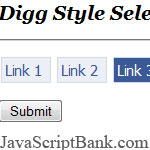 Nếu có tham gia Digg, hẳn các bạn biết về trình đơn chọn chủ đề của website này; một trình đơn chọn khá đơn giản nhưng rất hiệu quả khi sử dụng. Loại trình đơn này được tạo với sự kết hợp của CSS, HTML và JavaScript và bài viết hướng dẫn JavaScript này sẽ chỉ bạn cách tạo ra một trình đơn tương tự như vậy mà không cần phải dùng thêm bất kì một thư viện JavaScript nào.
Nếu có tham gia Digg, hẳn các bạn biết về trình đơn chọn chủ đề của website này; một trình đơn chọn khá đơn giản nhưng rất hiệu quả khi sử dụng. Loại trình đơn này được tạo với sự kết hợp của CSS, HTML và JavaScript và bài viết hướng dẫn JavaScript này sẽ chỉ bạn cách tạo ra một trình đơn tương tự như vậy mà không cần phải dùng thêm bất kì một thư viện JavaScript nào.
- Demo
- Phóng to
- Tải lại
- Cửa sổ mới
Miễn phí web hosting 1 năm đầu tại iPage
Nếu bạn vẫn còn đang tìm kiếm một nhà cung cấp hosting đáng tin cậy, tại sao không dành chút thời gian để thử với iPage, chỉ với không quá 40.000 VNĐ/tháng, nhưng bạn sẽ được khuyến mãi kèm với quà tặng trị giá trên 10.000.0000 VNĐ nếu thanh toán cho 24 tháng ~ 900.000 VNĐ?
Có trên 1 triệu khách hàng hiện tại của iPage đã & đang hài lòng với dịch vụ, tuyệt đối chắc chắn bạn cũng sẽ hài lòng giống họ! Quan trọng hơn, khi đăng ký sử dụng web hosting tại iPage thông qua sự giới thiệu của chúng tôi, bạn sẽ được hoàn trả lại toàn bộ số tiền bạn đã sử dụng để mua web hosting tại iPage. Wow, thật tuyệt vời! Bạn không phải tốn bất kì chi phí nào mà vẫn có thể sử dụng miễn phí web hosting chất lượng cao tại iPage trong 12 tháng đầu tiên. Chỉ cần nói chúng tôi biết tài khoản của bạn sau khi đăng ký.
Nếu muốn tìm hiểu thêm về ưu / nhược điểm của iPage, bạn hãy đọc đánh giá của ChọnHostViệt.com nhé!
To note here is the inclusion of the "digg_selector.js" file which we will look at next. Also important is the hidden field with the id of "hidden_data". Since what we're doing is replacing the functionality of radio buttons with nicely styled links, we need another way to get the information submitted and we do that with the hidden field. That's where the Javascript file comes in:
window.onload=function() {
var container = document.getElementById('container');
var containerAnchors = container.getElementsByTagName('a'); // get anchors
for(var j=0;j<containerAnchors.length;j++)
{
containerAnchors[j].onclick = handleClick;
}
};
function handleClick()
{
document.getElementById('hidden_data').value = this.id;
var container = document.getElementById('container');
var containerAnchors = container.getElementsByTagName('a');
// unhighlight all the links
for(var j=0;j++;containerAnchors.length;j++)
{
containerAnchors[j].style.backgroundColor = "#eceff6";
containerAnchors[j].style.color = "#3b5998";
}
// highlight the link that was just clicked
this.style.backgroundColor = "#3b5998";
this.style.color = "#ffffff";
}
This is simple - there are just 2 functions. Looking at the first one:
window.onload=function() {
var container = document.getElementById('container');
var containerAnchors = container.getElementsByTagName('a'); // get anchors
for(var j=0;j<containerAnchors.length;j++)
{
containerAnchors[j].onclick = handleClick;
}
};
When the page is loaded, we get all the anchors in the container div (these anchors are the digg style selectors/buttons or whatever you want to call them). Then, inside the for loop we attach an event handler to each anchor, which executes when the anchor is clicked. The event handler is a function called handleClick(), which we look at now:
function handleClick()
{
document.getElementById('hidden_data').value = this.id;
var container = document.getElementById('container');
var containerAnchors = container.getElementsByTagName('a');
// unhighlight all the links
for(var j=0;j<containerAnchors.length;j++)
{
containerAnchors[j].style.backgroundColor = "#eceff6";
containerAnchors[j].style.color = "#3b5998";
}
// highlight the link that was just clicked
this.style.backgroundColor = "#3b5998";
this.style.color = "#ffffff";
}
The line document.getElementById('hidden_data').value = this.id; gets a hold of the hidden field we talked about earlier, and dynamically sets its value to this.id . So what is this.id? Well, this refers to the anchor that gets clicked on. So this.id gets the id of the anchor. The hidden field is set, and when the form is submitted we can get the value of the hidden field in the $_POST['hidden_data'], assuming you're using PHP.
Finally, here's the CSS stylesheet, which needs to explanation:
body
{
font-family: "lucida grande", tahoma, verdana, arial, sans-serif;
font-size: 15px;
}
a:link {color: #3b5998}
a:visited {color: #3b5998}
a:hover {color: #3b5998}
a:active {color: #3b5998}
h1 {
font-family: Georgia, serif;
font-style: italic;
font-size: 20px;
font-weight: bold;
}
hr {
color: #A8A8A8;
height: 1px;
}
#container {
margin:0;
margin-top: 20px;
margin-bottom: 20px;
}
.digg_style_link {
color: #3b5998;
padding: 3px;
margin: 3px;
margin-bottom: 20px;
background-color: #eceff6;
text-decoration: none;
border: 1px solid #d4dae8;
}
That's pretty much all there is to it.
Source : http://localhost/topic-selectors-digg-style.html
- Lượt gửi (0)
- Mới
Save up to 630$ when buy new iPhone 15
GateIO.gomymobi.com
Free Airdrops to Claim, Share Up to $150,000 per Project
https://tooly.win
Open tool hub for free to use by any one for every one with hundreds of tools
chatGPTaz.com, chatGPT4.win, chatGPT2.fun, re-chatGPT.com
Talk to ChatGPT by your mother language
Dall-E-OpenAI.com
Generate creative images automatically with AI
AIVideo-App.com
Render creative video automatically with AI






 06/07/2010
06/07/2010 0
0
